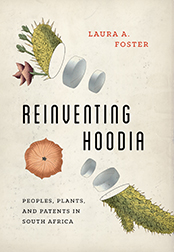Reviewed Book
Reinventing Hoodia: Peoples, Plants, and Patents in South Africa. Laura A. Foster, Seattle: University of Washington Press, 2017, 232 pp.

Reinventing Hoodia is a multidisciplinary study of a number of legal and scientific entanglements involving San peoples and the plant commonly known as Hoodia. It focuses especially on benefit-sharing agreements signed by the South African San Council, first with the South African Council for Scientific and Industrial Research and subsequently with transnational research and consumer goods companies and South African Hoodia growers’ associations. Foster situates these agreements within colonial and apartheid histories of science and law, in which both San peoples and Hoodia plants have often been excluded from consideration as political actors.
This book is thus demonstrative of a decolonial feminist technoscience approach, which is frequently invoked as an analytical frame guiding the book’s methodological, theoretical, and representational orientation. The book builds on scholarship in postcolonial studies, feminist science studies, and critical legal studies, which Foster pursues with an eye toward strategic sites of intervention. The book is methodologically multidisciplinary, and its account of Hoodia does not privilege conventional historical or ethnographic approaches. Rather, the analysis is developed out of engaged legal scholarship seeking forms of alliance with San peoples.
The book takes a materialist analytical approach, examining the plant as a material body as well as considering the material effects of the body of patent law. Reinventing Hoodia describes three different materializations of Hoodia that are manifested through scientific and legal practices: as a plant in nature, as an isolated molecule, and as a functional food. It considers the manifestations and contestations of colonial and apartheid history in each of these material-discursive formations, which Foster presents as three different scales of analysis.
For example, benefit-sharing agreements construct the plant as a part of nature that was long a part of San traditional knowledge. In doing so, Hoodia (known to San peoples as !Khoba) becomes entangled within San claims to autochthonous belonging in South Africa in ways that may reinforce nature/culture distinctions, construct indigenous peoples as close to nature, and discursively exclude San from consideration as modern political subjects. Likewise, South African scientists pursuing legal patents for their work isolating chemical compounds from the plant construct Hoodia as a molecule. This aids their efforts to challenge the historical construction of South Africa as a source of raw material, while reinforcing the valuing of their knowledge over that of San peoples. Finally, the functional food industry constructs Hoodia as a cultivated plant. This materialization of Hoodia as a natural extract once again draws on the association of Hoodia with nature and traditional San knowledge, which tenuously supports both San and Afrikaner claims to belonging, while sometimes reinforcing racialized and gendered forms of marginalization.
At various times, Reinventing Hoodia shows these materializations could challenge, reformulate, or reinforce colonial hierarchies of race, ethnicity, and gender. Indeed, Foster undertakes a nuanced examination of how differing materializations of Hoodia variously challenge or reify the marginalized positions of San peoples, women, and South Africa, suggesting both complicated relations of power and sites for potential intervention. Just as significantly, however, Foster demonstrates the underlying similarities between these different ways of knowing. Each is developed within an established tradition, and each is oriented toward claims to belonging in neoliberal South Africa. Rather than contrasting San ways of knowing with those of laboratory researchers, white farmers, or corporate lawyers, Foster’s materialist approach analyzes them as interrelated practices within the same analytical frame. This importantly challenges the marginalization of indigenous peoples in scholarly writing as well as in legal practice. Indeed, Reinventing Hoodia maintains a sensitivity to San self-making and political agency within legal and scientific institutions that are structured to deny their presence as modern political subjects.
Furthermore, the book foregrounds the agency of Hoodia itself, the materiality of which sometimes supports and sometimes complicates or subverts claims to know the plant. For example, the distribution of the plant in South Africa is such that not all San peoples have histories of using it, and not all traditional users are San. Likewise, the chemical composition of Hoodia frustrates the desires of industrial researchers and growers. In this way, Foster’s materialist approach challenges colonial histories of non-human species as well as the relegation of indigenous peoples and women within those histories.
Many of the book’s takeaways relate to the legal and scientific structures within which indigenous knowledge is recognized. Foster develops the concept of “patentability,” or the ability of a form of knowledge or practice to gain the legal status of a patent, and how current patent systems limit the ability of benefit-sharing agreements to substantively challenge the colonial relations they seek to amend. Legal and scientific structures are developed around markets and political relations, which, Foster argues, form an obstacle for legal and scientific work oriented toward goals of social justice.
The book is recommended for medical anthropologists interested in natural products development or other cases in which indigenous peoples seek restitution and social justice through legal action. More broadly, this book offers resources for those pursuing decolonial approaches to practices of research and representation. While its concise analysis may not satisfy those looking for comprehensive historical work or extensive ethnographic thick description, its deliberate and reflexive approach may be particularly instructive for researchers planning critical studies with marginalized peoples. For those interested in departing from ethnographic modes of writing characterized by anonymized subjects and detached forms of reflexivity, Reinventing Hoodia engages feminist traditions of reflexivity that offer an alternative to canonical anthropological treatments of the topic. The book also includes appendices with resources for working with indigenous peoples as well as strategies for patent litigation. In this way, it aims to be a resource for further critical scholarship and legal action involving indigenous peoples. It is recommended for undergraduate and graduate courses concerned with indigeneity or nature in relation to science or law.